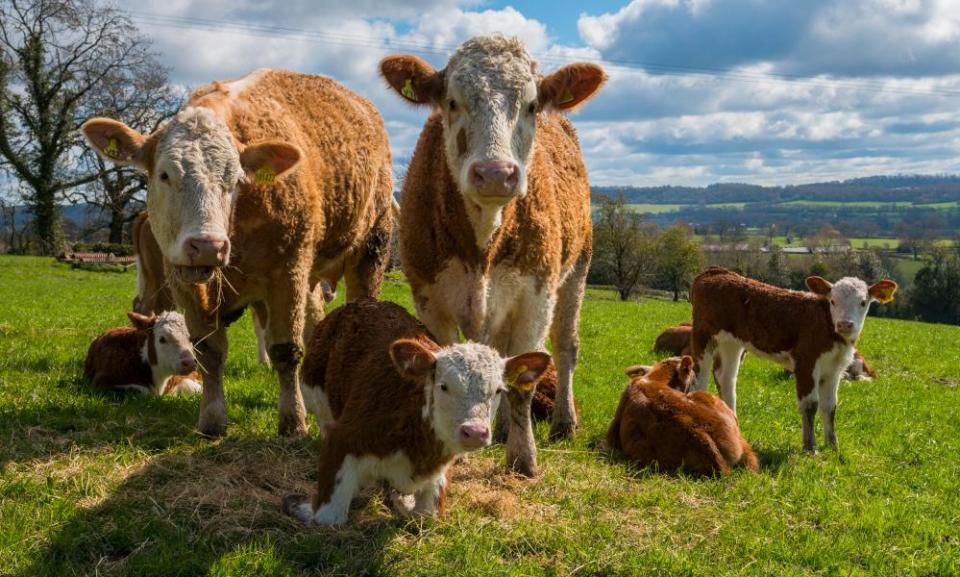Farmers' union issues warning after teacher trampled to death by cows

A schoolteacher from North Yorkshire has become at least the second member of the public to be trampled to death by cows in the UK this year, as the National Farmers’ Union (NFU) urged walkers to let their dogs off their leads if they are charged by cattle.
Dave Clark, the deputy headteacher at Richmond school, was killed in a field in Richmond on Monday evening while walking his dogs.
Exactly how the popular teacher died will be subject to an inquest as well as an investigation by the Health and Safety Executive (HSE). He is at least the second member of the public to be killed by cows while dog walking this year. An 82-year-old man was trampled to death in front of his wife near Ingleton, in the Yorkshire dales, in June.
Between March 2000 and March 2020, 98 people were killed by cattle in the UK, according to the HSE. Of those, 22 were members of the public, with the rest being either farmers or farm workers.
Last year, two people, both farmers, were killed by cattle. A 73-year-old was knocked over and killed by a cow in a pen while treating a newborn calf. A 37-year-old farmer was trampled to death by his bull when attempting to direct it into a pen.
Members of the public killed by cows are almost always walking on public footpaths or commonly used rights of way when they are attacked, the HSE says, and are very often accompanied by dogs. More often than not, calves are involved, with heifers protecting their young.
In 2018 to 2019, the HSE investigated 43 incidents involving people being hurt or killed by cattle.
A dog was present in 18 of the 43 incidents reported, mainly with members of the public on footpaths. In eight cases the dog was reported to be on a lead.
Stuart Roberts, the deputy chairman of the NFU, urged members of the public to let their dogs off the lead if they were approached by cows. “Generally, dogs will outrun cattle,” he said.
“There are things that everyone should remember. The classic is avoiding getting between cows and calves. Plus, keep dogs on leads, but if your dog is being threatened by cows, let them go. Cattle will chase dogs instead of you.”
Roberts also urged walkers to override their basic instincts and not run away from cows, but move away slowly: “Don’t run away. It’s almost counterintuitive but the best thing is to move slowly, steadily. If you run, they may chase you.”
The NFU is also campaigning for farmers to be allowed to make temporary diversions to footpaths to avoid fields where livestock are present. “In an ideal world you would put your livestock, particularly if you have less docile livestock, in a field with no public right of way. But some farmers may have footpaths in every field. We believe the law could be amended, though some walking groups are not supportive of it,” said Roberts.
Dairy cattle are generally considered to be more volatile than beef cattle, he said. The HSE bans farmers from keeping certain breeds in fields crossed by public rights of way.
Beef bulls are banned from fields or enclosures with footpaths unless accompanied by cows or heifers. “Bulls tend to be calmer if they are surrounded by their family,” said Roberts. “Any animal by itself is probably more anxious.”
In September last year, a coroner urged awareness of the dangers cattle could pose to the public after an 87-year-old woman was killed by cows at Linchmere Common, near Chichester in West Sussex.
Farmers can be prosecuted if their cattle maul walkers or farm workers. In 2015 a Staffordshire dairy farmer was given a four-month suspended sentence and fined £133,000 after a Holstein bull rammed one of his employees to death. In 2013 a farmer in Cornwall was ordered to pay £20,000 after a walker sustained life-threatening injuries when she was trampled by cows while walking on a public footpath in St Martin, near Helston.

 Yahoo News
Yahoo News 